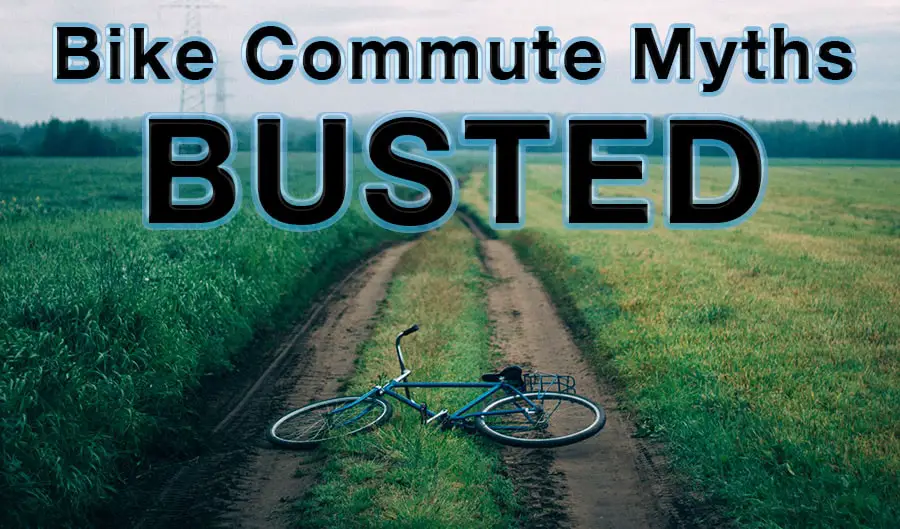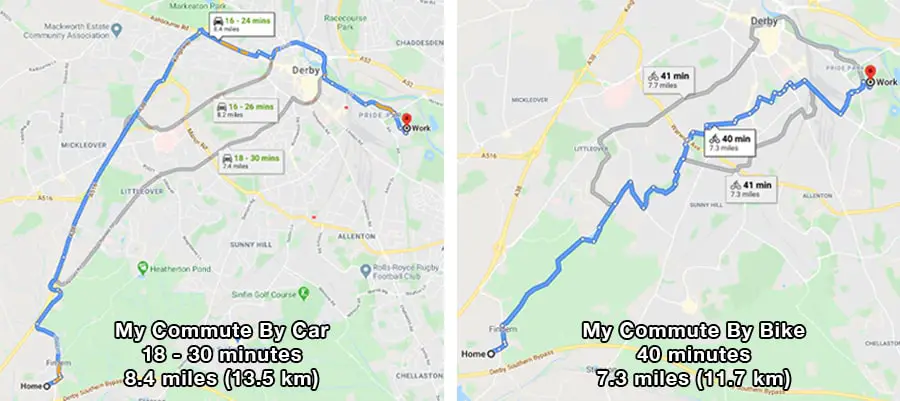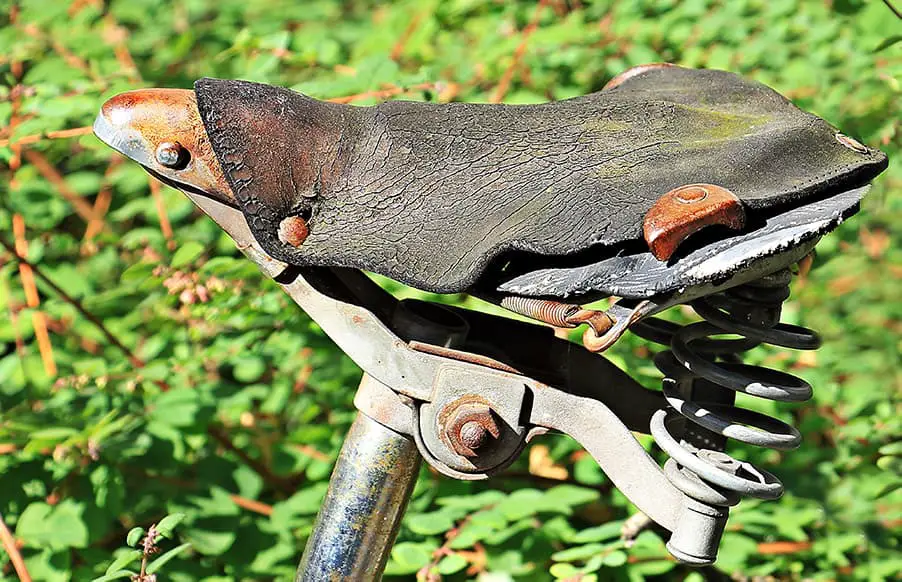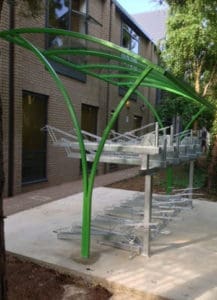
When it comes to Bike Commuting, there are many misconceptions, untruths and myths. There are also a number of excuses that people made when talking themselves out of taking the plunge. If you are just getting started, these myths can be enough to completely put you off and are mostly unfounded and in all cases completely manageable issues.
Most, if not all, negative perceptions (myths) with regards to bike commuting are false and with a little knowledge and experience, these can be easily mitigated with adequate planning and preparation.
The myths that we expose in this article are:
- Bike Commuting is Dangerous – MYTH
- Bike Commuting is Slower than Driving – MYTH
- I Live too Far Away to Bike Commute – PARTIAL TRUTH
- I am Not Fit Enough to Bike Commute – MYTH
- I am Too Overweight to Bike Commute – MYTH
- I look Bad in Lycra – MYTH
- There are No Showers and Changing Facilities – PARTIAL TRUTH
- Bike Commuting will Make Me Sweat and Smell Bad – MYTH
- It’s too Expensive to Bike Commute – MYTH
- Bike Commuting Will Make Me Impotent – MYTH
- There’s no place to park my bike at work – MYTH
- The weather’s too rotten to Bike Commute – MYTH
- There is Too Much Traffic to Bike Commute – MYTH
- Bike Commuting Takes Too Much Preparation – MYTH
- My Company Doesn’t Offer a Cycle to Work Scheme – MYTH
We explore the most common myths in this article and give you practical advice on how to prepare and manage these issues without too much trouble. We smash the excuses wide open and bust the myths so you can arm yourself with more knowledge when deciding if bike commuting is right for you!
1. Bike Commuting is Dangerous
Verdict – Myth
If you think that bike commuting is dangerous, you are are in good company and you do have a large amount proportion of public perception supporting your view. In 2014, 64% of people surveyed by the UK’s Department of Transport said they believed it was too dangerous for them to cycle on the road.
The majority view of the dangers of bike commuting is rarely backed up with factual data or statistics and is often based anecdotal evidence, or gut feel, that forms peoples view of the dangers of bike commuting. This false premise is enough to stop people taking the plunge and is a major obstacle in increasing uptake of bike commuting.
The major issue with this public perception is that news of a bad cycling accident with stand out, often a bad accident leads to very bad consequences for the rider. This is not a surprise, a lycra clad cyclist will not fare too well against a 40ft articulated lorry and so the consequences of an accident are enough to put you off for life.
As more and more cycling infrastructure is built in our cities and towns, the safety risks of bike commuting are continually on the fall from traditional hazards, although this will inevitably bring other hazards to bear than need to be respected and mitigated accordingly.
To address the questions of bike commuting safety, we should fall for the emotion of the tragic consequences that can occur when a cyclist is involved in a traffic collision. We need to look at the statistics.
According to a report released by the Department of Transport in 2019, the number of casualties in road accidents from the cycling population was 11%. This is lower than walkers who made up 14% of the total casualties. The reported casualties of cyclists were 17,470 compared to nearly 100,00 casualties from the car user population.

This number has remained consistent over a number of years and so there is stability in the level of danger bike commuting brings.
From these casualties, the number of deaths reported hovered around 100. This was 102 in 2016, so again, fairly consistent. There are always going to be some inconsistencies in the numbers, for example, not all incidents are reported and so there will be gaps in the data but these are encouraging signs.
There are no signs that this number is increasing, and with the numbers of cyclists on our roads increasing slowly, this is a positive sign that the safety of bike commuters is continuously improving.
Accidents are, unfortunately, a way of life and every time you leave the relative safety of your house you expose you’re self the risks and increase the chances of being involved in an accident. The statistics show that the chances of you being killed or seriously injured during your bike commute is extremely low.
There are ways you can make yourself safer so head over this article for top tips on reducing the risk of an accident even further. The best advice is to make sure you wear a helmet, follow Highway Code and make sure you are a courteous road user at all times.
2. Bike Commuting is Slower than Driving
Verdict – Myth
I am calling this one a myth for a few reasons. Obviously, cars are faster than bikes. What needs to be taken into account here is all the additional time it takes when you drive and compare a like for like commute.
The first consideration is traffic. Rush hour traffic can cause havoc to commute time when you go by car. Depending on the time you need to set off, commute time an vary significantly. Also, you are at the whim of other road incidents not occurring on your route, or surrounding routes, that impede your progress.
On a bike, traffic is largely irrelevant, especially if you can take some of your commute off the road and through more green routes such as country lanes and parks. You can also move around idle traffic by using cycle lanes and footpaths, where bikes are allowed negating the delays of a congested route.
If I look on Google Maps for Monday morning commute, leaving at 08:00, it predicts my commute will take anywhere between 16 and 24 minutes. The same day at the same leaving time puts the journey time at 40 minutes by bike. Granted, this does take a shorter route by taking advantage of off-road cycling.

In reality, I have never driven my commute in 24 minutes on a Monday morning, leaving at 08:00. It is always closer to 40 minutes. I also cannot park on-site where I work so I have a 10-minute walk at the other end. I can park my bike right by the entrance which is another consideration that shouldn’t be overlooked. I can also cycle it in 33 minutes usually so faster than the Google Maps prediciton.
The added benefit of the bike commute is that it is very predictable and will not vary much around the normal duration. There are some issues with maintaining this such as punctures, if you get a flat tyre, all bets are off. You are going to be delayed.
Traffic and travel time are not the only considerations. If I drive to work, I will shower before I go. If I cycle, I shower when I arrive at work. You would think this would equalise the total duration of the commute. However, I have found that showering and dressing at home take longer, and I will need longer to get ready compared to showering, dressing and getting ready at work.
When you bike commute, I have found I do motivate yourself to get up and out quickly and then, when at work, I don’t spend extra time procrastinating, talking, delaying or busying myself with other tasks which reduce the total time taken to commute.
Overall there is not a lot of difference between my bike commute and my car commute when it comes to time taken. If anything a bike commute is much more consistent and predictable, but you do have to put a bit more effort in!!
3. I Live Too Far Away to Bike Commute
Verdict – Partial Truth
Whilst distance on its own should not be a excuse not to bike commute, you do have to pay attention to how long your commute will take. We don’t all have unlimited time and no business will be happy with you rocking up at midday.
The table below summarises the length of time taken for different distance commutes, assuming a 12 mph average speed, which is achievable for the average bike commuter.
| Distance | Commute Time |
| 5 miles (8 km) | 25 minutes |
| 7 miles (11 km) | 35 minutes |
| 10 miles (16 km) | 50 minutes |
| 15 miles (24 km) | 1 hour 15 minutes |
| 20 miles (32 km) | 1 hour 40 minutes |
As can be seen from the table, commutes of 20 miles are more start to take a large proportion of time to complete. Increasing your average speed can help here but for the average bike commute, upwards of 20 miles is difficult to do and a big drain on time.
It is important to remember that this is not just your commute, but also your daily exercise, so this will play into your decision into how far is too far. If you usually commute an hour each way by car and, then spend 90 minutes per day in the gym, increased bike commuting time may ultimately be neutral in terms of time spent commuting + exercising.
I think I would personally struggle to commute at distances greater than 20 miles and so you will need to weigh this up personally based on your other life commitments. This article gives advice on bike commuting long distances.
4. I am not Fit Enough to Bike Commute
Verdict – Myth
Cycling is one of the easiest forms of aerobic fitness exercise to pick up as a beginner, whatever you fitness level. It is the one form of physical exercise that is easy to tailor to your personal fitness level by reducing effort accordingly, and, what a great way to start to implement a healthier fitness regime than to combine it into your daily commute.
Bike commuting is enough exercise for you if you ride for at least 15 minutes each way (30 minutes in total) per day, five days a week. Other benefits include metal well-being and stress reduction. Alternating such exercise with strength, upper body, balance, and flexibility training is also essential.
Your bike commute can be a great way to contribute to improving your overall fitness levels, and you can do it in the time you would usually be sat sedentary in your car.
Depending on your current fitness level, your commute distance and the route difficulty, you may have to build up slowly to a complete, 5 days a week, bike commuting regime but there is no need for this to stop you getting started.
Cycle Scheme has a great 8-week plan that can take you from novice to intermediate with ease, culminating in a 10-mile ride, in just 8 short weeks. This plan eases you nicely into a full, 5 day a week, bike commute for a distance of 10 miles. The plan is aimed at complete beginners. If you feel you can cycle for longer, go ahead, just keep the times relative to each other on the plan. A summary of the plan is below that anyone can use to start to build up to a full bike commuting schedule.
And there you have it. With this plan, you’ll go from total beginner to completing a 10-mile bike ride with ease in eight short weeks. The route you pick is up to you. For complete beginners, it is recommended to stick to a relatively flat route. If you want to challenge yourself, choose a route with some hills, or better still, mix it up to keep the interest and motivation high.
If you already have a short commute then the training plan can be used within your commuting journey time which will get you in the right place for bike commuting more frequently and longer-term. Just don’t bike commute every day at first and risk burn out!
This may seem like a long road to get yourself into bike commuting but this will be a complete lifestyle habit change that will benefit you for years to come. Just start, and don’t let your current lack of fitness stop you. Fitness improvement can start today!
5. I am too Overweight to Bike Commute
Verdict – Myth
You can follow the same advice given in Myth No. 4 if you feel too overweight to bike commute. Healthy eating and a calorie deficit, combined with regular exercise is the best way to tackle being overweight and there are no short cuts.
Daily bike commuting can play a massive role in helping you hit your weight loss goals. The good news is, there isn’t a weight limit to get started. You can start right away and ease yourself into it as mentioned in Myth No. 4. Don’t worry about it, take action and use your commute time to improve your overall health and fitness.
6. I Look Bad in Lycra
Verdict – Myth
Everyone feels a little self continue when they first pull on their lycra cycling gear. It is very figure hugging and this is for the reason of reducing air resistance when riding.
Here is the secret to this problem….. you don’t have to wear lycra. I know this is a shocking revelation, but you don’t!! Whilst, close-fitting clothing will give you a slight percentage benefit in average speed, this is completely unnecessary and negligible for the average bike commuter. Stopping at a set of traffic lights unexpectedly and any time benefit you have made up is now gone!
You can wear any clothing when bike commuting, loose fitting and comfortable clothing is best as well as clothing that is breathable and wicking. They are the only relevant guidelines. If you are racing in the tour de-France then you may want a 1% edge here, but it is simply not necessary for your bike commute, so don’t worry about it.
If you still feel that wearing lycra is the right thing to do, then there are ways to ease how self conscious you feel. Bid shorts, shorts that fasten over your shoulders, are great to ensure you are not giving other road users a flash of your bum crack. Bid shorts will stop your shorts from riding down when bike commuting so is a good way to protect your modesty.
Also, a front zipped cycling jersey, rather than a pull over type, feels a little more comfortable and looser fitting in general so may easy your insecurity.
Whatever solution you go for, don’t let this put you off. In reality, nobody will give you a second look in the midst of a rush-hour commute, they are too busy getting where they need to be so whether lycra-clad or not, you can still use cycling to work as a great alternative commuting method.
7. There are No Showers and Changing Facilities

Verdict – Partial Truth
Ok I get it, when you bike commute, you will get hot and sweat. I certainly do. I use commuting as one of my forms of weekly exercise and so I like to work hard and get a sweat up. Also, the harder I work, the shorter my commute time (at least by a few minutes). I really do appreciate access to a shower and change facilities when I arrive at work to freshen up before the working day starts.
For those of you without access to a shower when you arrive at work, I feel for you. I think it would put me off too, but it definitely doesn’t have too. Sweating doesn’t cause body odour and so a sweaty bike commute may not have to leave you stinking. It is actually the sweat reacting to bacteria on your skin that causes the pong!
That being said, it is difficult to stop sweat from being unpleasant for everyone else around you. You could try showering before you bike commute, an unconventional and counterintuitive approach but removal of bacteria before sweating occurs may be a tactic that works for you.
You could also look to wash in a sink in the WC at work but all over spunge baths are best saved for hospital’s!! No one wants to walk into the WC with you naked in front of the mirror.
You could look to reduce the effort you put into your ride and ride at a much more casual pace, reducing the sweat and leaving you fresh for a days work. This depends on the distance and the weather but if it works for you, you could even bike commute in a suit!!
I think there is a partial truth here that bike commuting with no shower is a difficult one to solve. It will depend on your culture and the tolerance to smelly people as well as how comfortable you feel after a hot commute. Its all down to personal choice.
We have a great, in-depth article here to help you decide if bike commuting with no shower is right for you.
8. Bike Commuting will Make Me Sweat and Smell Bad
Verdict – Myth
See myth No.7. I agree, if you bike commutes a reasonable distance and work hard, you will sweat, especially in warm climates or hot days. However, sweat doesn’t actually smell, it’s odourless, as mentioned earlier, but the sweat reacting with bacteria on your skin is the mechanism that creates the unpleasant odour.
If you have access to shower faculties at work, then this is no issue whatsoever but may be difficult to manage with no shower. We have a great, in-depth article here to help you decide how to combat the bike commute with no shower.
9. It’s too Expensive to Bike Commute
Verdict – Myth
Bike equipment can be expensive, this is a fact of life and very much of a ‘you get what you pay for’ position.
However, it doesn’t have to be. This will be down to how much you are willing to spend and how much you can personally afford. You can bike commute on anything with two wheels and you do not NEED any specialist clothing. I have been known to bike commute on my £250 mountain bike with normal clothes. It takes a bit longer but it is achievable.
The increased investment to get specialise road bikes and cycling gear may help to make your commute more comfortable, and a little faster, but it is not essential.
With tax-free schemes, such as Cycle Scheme, it has never been more affordable to bike commute. These schemes enable you to by your bike, clothing, accessories, safety and security equipment all without paying tax and as a salary deduction over a period of time. There has never been a cheaper time to invest in your bike commute and no real excuse.
In addition to this, bike commuting can actually save you money over the long run with some people saving upwards of £2000 per year when compared to car commuting.
10. Bike Commuting Will Make Me Impotent
Verdict – Myth

There are claims and worries that cycling may damage reproductive organs and harm sexual function. Many people have reported numbness to the genital area, lasts up to a number of days following long rides.
According to this article by the Harvard Medical School, there are some truths behind this claim but this applies to people who spend a very high proportion of time riding.
In the largest study of cyclists to date, researchers enlisted nearly 5,300 male riders to ascertain any links between how many hours per week they rode and whether they had experienced symptoms of ED within the past five years or had doctor-diagnosed infertility.
In a recent study, researching nearly 5,300 male riders, riding between 3.75 hours per week to more than 8.5 hours per week there were no positive associations found between cycling and erectile dysfunction or cycling volume and infertility.
Cyclists taking part in the trial included many who rode 200 miles a week – suggesting regular commute or club riding isn’t as harmful as feared.
Overall, the research team maintained that the many health benefits of cycling — aerobic challenges, burning calories, improving muscle strength and tone, and exercising key joints without the impact of running — far outweigh any potential health risks.
In order to help reduce this risk further, the following measures can be taken:
- Saddle design and fit – use a ‘no-nose’ saddle if this helps, trial different designs to find the most comfortable
- Riding position – too much ‘torso forward’ riding can cause numbness of the genitals, shift position regularly though-out your commute
- Adjust saddle angle – tilt the saddle forward a little to relieve the pressure
11. There’s no place to park my bike at work
Verdict – Myth
It may be true that your particular workplace doesn’t have designated facilities to securely park your bike but the lack of bike storage facilities it is a pretty feeble excuse, isn’t it?? You are not going to let this stop you?? Are you?? Let me try and convince you that this is easy to overcome!
Generally, smaller companies may not be aware of the benefits of bike commuting for its employees and also be blissfully ignorant in the facilities they could offer to support this. Large companies have the benefit of dedicated ‘Live Well’ teams and Occupational Health professionals to continuously lookout for the health and well being of their employees. This is rarely a luxury that smaller companies can afford.
If the companies employees have not mentioned it before, bike commuting, as a beneficial option for its employees may simply not be on the radar. Do not let this stop you!!
Having a frank and open conversation with the powers that be in your company may be enough to get something organised. This conversation just may not have happened before. Most employers will be happy to accommodate these requests, the smaller companies may even have more options than larger companies dictated by the process, policies and red tape.
Even if you have to leave your bike in a storeroom, chain it to a fence or park it next to your desk, there will probably be a solution for you here and a simple conversation can open this up as a credible option.

In most cases, just a spare space to store bikes will be sufficient but for a more permanent solution, Bike Dock Solutions offer bike racks for a little as £5500 + VAT which your company may be open to purchasing to support you new healthy commute lifestyle.
It is definitely worth a conversation to see if you can champion this within your business to promote healthy bike commuting for more of the companies employees.
12. The weather’s too rotten to Bike Commute
Verdict – Myth
The only reason this is not a complete myth is down to safety. If the weather makes your commute unsafe, such as snow and ice cause dangerous riding conditions then this would be a reason to give the bike commute a miss.
In most climates, certainly in the UK, this level of extreme weather is rare and so your bike commute can only be affected a minority of the days through the year. In most cases ‘bad’ weather is nearly a little bit of rain or cold temperatures. Nothing to worry about.
The right clothing and the right mindset is enough to tackle most ‘rotten’ weather conditions.
We have great resources on bike commuting in the rain and bike commuting in winter that will help you to completely smash this excuse out of the park.
13. There is Too Much Traffic to Bike Commute
Verdict – Myth

Driving in traffic can be really intimidating, especially to the beginner bike commuter. I remember my first few commutes being scary and me being very unconfident in my ability lead to some hesitation in decision making.
To ride safely on busy roads you need to have a good position on the road where you can influence and control the behaviour of drivers and the traffic around you. You need to make sure that you signal your intentions clearly and make clear and confident movements.
Whilst riding does have its risks the statistics of riding are still favourable when it comes to accidents. That being said, bike commuting on busy roads can be a bit intimidating when you first start out. Cycling through busy streets can often put people off being consistent with their bike commute but with a few tips, you can confidently take to the streets despite busy roads.
To help you drive on busy roads with more confidence, we have the following tips:
- Maintain a good road riding position
- Make your intentions clear
- Do NOT undertake
- Watch Out For Blind Spots and Turning Circles
- Be Road Confident
- Undertake Cycle Training
These tips for riding in traffic are described in more detail here. The advice in this article will hopefully enable you to be a more confident bike commuter when on busy roads and in traffic. The key advice is being confident in your ability, upgrade your knowledge and embrace the traffic, becoming part of it and riding with it.
14. Bike Commuting Takes Too Much Preparation
Verdict – Myth
Does it??? How much extra preparation do you think bike commuting needs over and above car commuting? You still need to get lunch ready for the next day. You still need to get clothes washed and ironed and shoes cleaned.
The only extra preparation is in having clothes, a towel and toiletries at work so you don’t have to carry them. This can be done on Monday morning, either on the bike or in the car (I used to drive on Monday’s and take everything I needed for the week, including 5 lunches that I would leave in the fridge.
Whilst this extra bit of foresight and readiness will make your week run more smoothly, there is little extra to do above and beyond your normal routine.
15. My Company Doesn’t Offer a Cycle to Work Scheme
Verdict – Myth
All companies have the ability to offer a cycle to work scheme such as Cycle Scheme. As long at staff are paid via Pay As You Earn (PAYE) then your company, irrespective of size can apply for Cycle Scheme.
Companies may not be aware of the benefits, or their eligibility, for cycle schemes, especially smaller companies. You can talk to them about this and lobby for a scheme to be set up in your company if one doesn’t exist already.
Cycle to work schemes offers employers a raft of benefits which are briefly outlined below.
- Money-Saving – Typically, organisations can save 13.8% of the total value of salary sacrifice because of reductions in the amount of National Insurance Contributions due.
- Fitter, healthier staff – improved productivity – One study found that people who cycle to work experienced a 39% lower rate of all-cause mortality compared to those who did not – even after adjustment for other risk factors, including leisure-time physical activity.
- Improved attendance – As well as improving physical health, cycling, has a positive effect on emotional health, improving levels of wellbeing, self-confidence and tolerance to stress.
- Environmental benefits – The average person making a typical daily car commute of four miles each way would save 0.5 tonnes of CO2, or 6% of their annual carbon footprint, by switching to cycling.Good news for your corporate social responsibility.
- Employer branding and PR – Cycle to work is good for employer branding and may, therefore, help your appeal to potential recruits. It demonstrates concern for the welfare of an organisation’s employees.
- Retention – A cycle scheme, like other salary sacrifice schemes, can act as one of those reasons why people may postpone changing jobs.
- Low-cost implementation – Local authorities, which have budgets to promote cycling, may well provide bike sheds free of charge or at a reduced cost.
- Capital Expenditure – The cost of cycling equipment can be treated as capital expenditure and therefore employers can claim capital allowances against it.
Summary
Whilst some of these myths hold some level of truth, this article shows that they can be overcome with a little bit of planning and preparation. Bike commuting is a really good option for people whioo want to do their bit for the environment, improve their health and save some cash and so these excuses and myths should not be a barrier for getting in the saddle.
If you are thinking about starting a bike commute and have any other ‘reasons’ not to, then leave a comment and get in touch and we will happily bust those myths for you too!!



